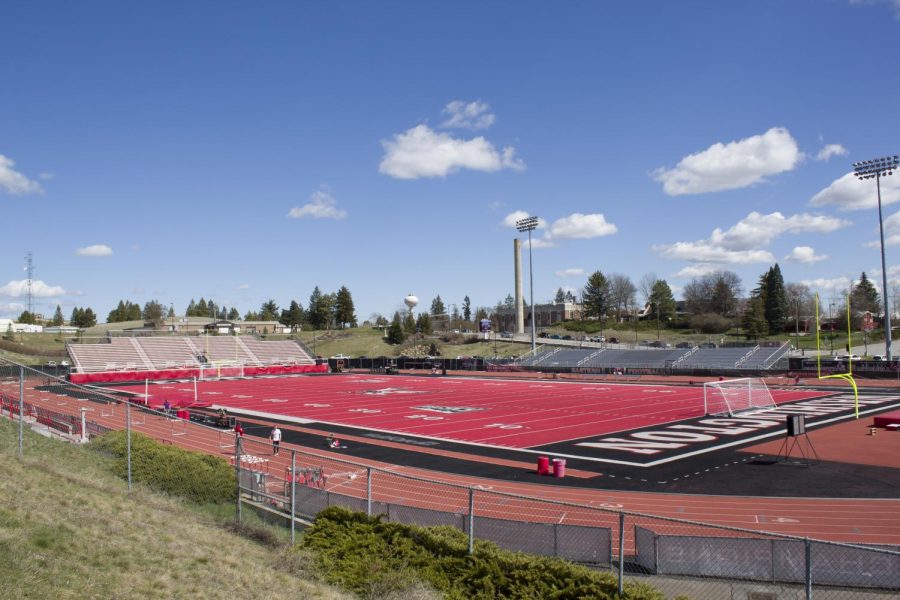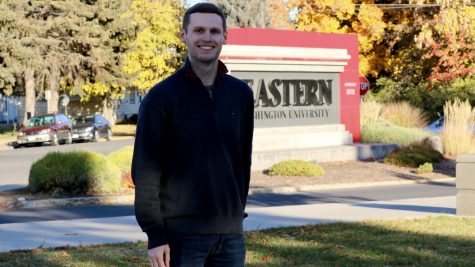Opinion: Roos field is in need of a face-lift
Woodward Field was originally constructed in 1967 for $1.5 million and was renamed Roos Field in 2010 after former Eagle lineman Michael Roos. Roos funded half of the 2010 project to bring in the iconic red turf that makes EWU’s football venue different than every other in the nation.
April 22, 2019

Taylor Newquist is the Sports Editor for The Easterner. The hyperbolic opinion expressed in this article is his own and does not necessarily reflect the opinion of The Easterner’s editorial board.
Roos Field is an awkward hybrid of a football venue. The rows of bleachers in the stands capture the feeling of a 1960s high school, clashing directly with the middle seats and booth hanging above.
Bystanders walking along Washington Street on gameday can watch with little to no obstruction, and wouldn’t need to pay the price of admission. Routinely you can find spectators catching all the action from outside the gates.
It is due time for Roos Field to receive a renovation, especially when it comes to the seating. On May 10, Athletic Director Lynn Hickey will propose a plan for renovations to the board of trustees, and Eagle boosters better be ready to open their wallets.
Originally constructed as Woodward Field in 1967 for $1.5 million, the EWU’s home for football is one of the oldest in the Big Sky. Only Cal Poly’s (1935) and Weber State’s (1966) stadiums are older than the Eagles’.
The last actual renovation came in 2004 and cost $4.5 million. Nine of the 13 BSC football stadiums have received renovations in the 15 years since EWU had its last. The red turf was a recent addition to the field, being installed in 2010 for $1 million, with $500,000 coming from former Eagle, Michael Roos, who it was subsequently named after.
The red turf may have separated Roos Field from every other football venue in the country, but it didn’t address the structural issues that leave it lacking as the area’s main stage destination. Last year EWU surpassed the field’s 8,600 person capacity in each of its home football games.
Nine of the 13 BSC teams have venues with a larger capacity than Roos Field, with each of those capable of housing over 10,000 fans. EWU brought in an extra set of old rickety bleachers for the Oct. 27 game against Idaho, bringing in 10,023 spectators.
Roos Field makes for a homey, small town vibe for watching a football game, which suits the Eagles, but changes need to be made. A complete overhaul could make empty seats a more regular occurrence, but enclosing the away-side stands would give a more legitimate feel to the complex—something an FCS powerhouse deserves.
Aside from the stadium, the majority of the EWU athletic facilities are in need of an upgrade, but before any internal damage can be assessed Roos Field needs a face-lift.
As of now, we don’t know how much money is going to be needed for the stadium renovations, but Hickey said that the athletic department is already making a “significant ask” from donors.
In 2012, the “Gateway Project” was proposed to the board of trustees with aims of expanding the seating to 18,000. That was overly ambitious. The project fell through after costs skyrocketed over $60 million.
A renovation plan in the range of EWU’s in 2004 will be more appropriate, but Hickey will have to spark multiple millions from Eagle donors. Right now EWU has other pressing issues, dealing with a $3.6 million budget shortfall and 2.5% decrease in enrollment from last spring. A stadium upgrade is due, but only time will tell if anything will be done about it.









